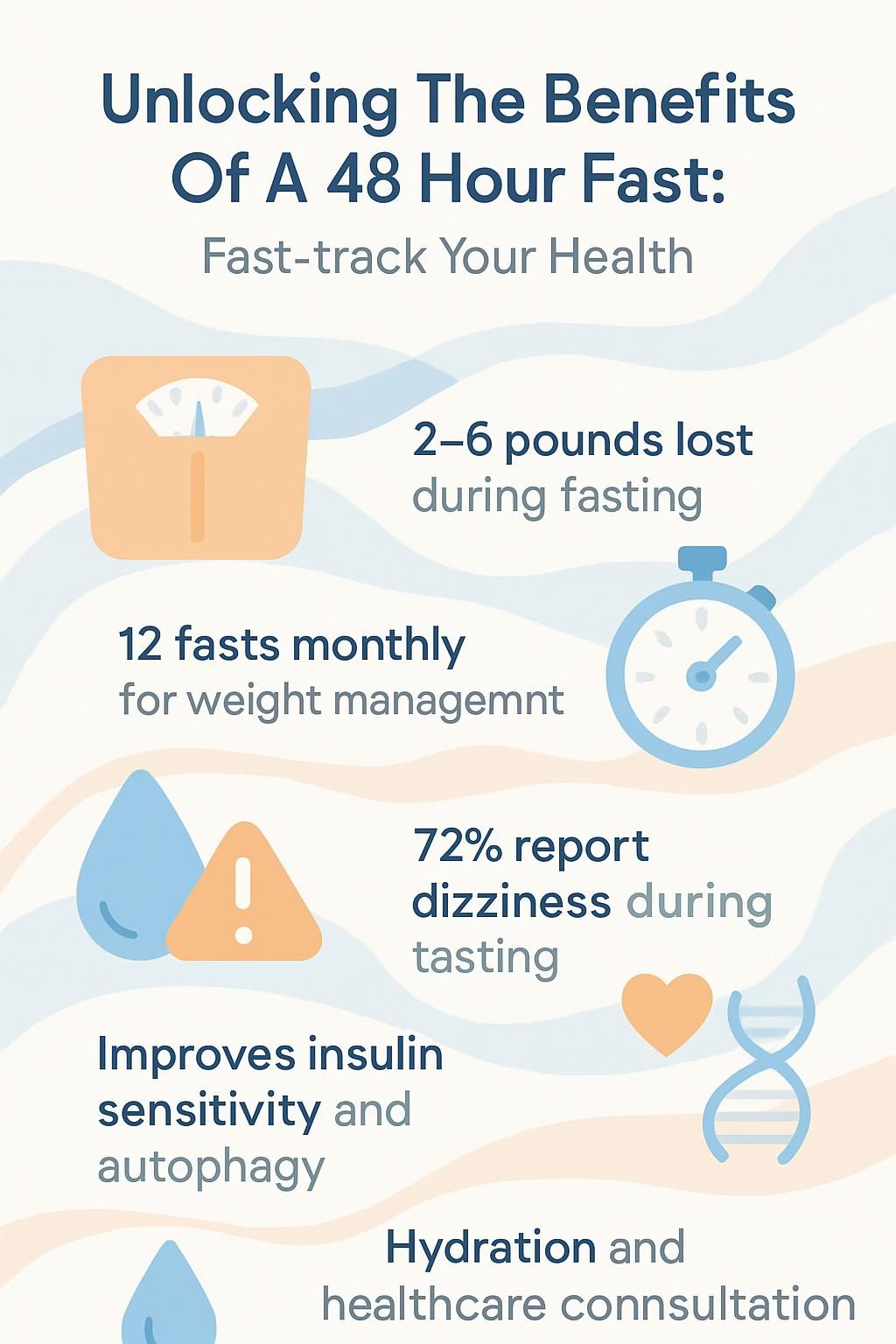Unlocking The Benefits Of A 48 Hour Fast: Fast-track Your Health
Our Nutrition Assistant AI Suite will transform your body. You will lose fat, get toned, and build muscle. Gain confidence and optimal health.
If weight loss has stalled or your energy feels flat, changing your routine can help. A 48-hour fast is a form of intermittent fasting where you pause food for two full days and rely on stored energy. During this fasting period, the body shifts from burning glucose from meals to using fat for fuel.
Early research suggests a 48-hour fast may support insulin sensitivity, cell metabolism, and fat loss. In this guide, you will see what a 48-hour fast involves, how to prepare, possible health benefits, and ways to do it safely.
Curious how fasting for 48 hours could affect your health? Keep reading.
Key Takeaways
- A 48-hour fast means no calorie intake for two consecutive days. Water, black coffee, or tea are allowed. Some repeat it up to 12 times per month for weight management, though medical guidance is wise.
- Evidence, including the 2014 review by Longo and Mattson, links longer fasts to improved insulin sensitivity, cellular clean-up called autophagy, and lower inflammation markers such as C-reactive protein.
- Typical short-term loss is 2 to 6 pounds. Much of the early drop is water, not true fat loss, due to glycogen depletion.
- Common side effects include hunger, dizziness, and fatigue. In a study of 768 people who fasted at least 48 hours, 72% reported symptoms.
- Key safety steps include steady hydration with electrolytes, a gentle refeed, and talking with a clinician first if pregnant, breastfeeding, or taking certain medications.

What Is a 48-Hour Fast?

A 48-hour fast is a planned pause from consuming any calories for two straight days. This extended fast encourages a metabolic switch from sugar to fat, which reduces the body’s reliance on constant snacking and meals.
What defines a 48-hour fast?
During a 48-hour fast, you avoid all food and any drink with calories. Water, black coffee, unsweetened green tea, and herbal tea are fine. Zero-calorie fluids keep you hydrated while you rest your gut.
Many people stop eating after dinner on Day 1 and have their next meal at dinner on Day 3. Sleeping through part of the fast makes the clock feel faster. Some build this longer fast into a monthly plan for weight management, though frequent long fasts can be hard on social life and training.
The rules are simple, but consistency takes discipline.
Going without food for 48 hours challenged my cravings, but I gained clarity and energy after the first day.
How does a 48-hour fast work?
Once you stop eating, stored glycogen, which is your body’s quick energy, fuels you for about 24 hours. As glycogen drops, insulin levels decline, and your metabolism switches to fat for energy. Ketone levels rise, and blood sugar often stabilizes.
Research suggests that longer fasts can improve insulin sensitivity and support weight loss in people with obesity or type 2 diabetes. Fasting also boosts autophagy, a clean-up process where cells break down worn parts so new components can be built. Many people rely on water, black coffee, or green tea to handle hunger waves.
Electrolytes, especially salt, help reduce headaches and dehydration. In my first 48-hour water-only fast, green tea eased cravings late on Day 1. Some people notice clearer thinking as inflammation lowers. Early trials also hint at small shifts in cardiovascular markers, though more research is needed.
Preparing for a 48-Hour Fast
Good preparation reduces stress on your body and helps you fast safely. A short warm-up period makes the first several hours easier.
How can I gradually reduce meal portions before fasting?
Cutting portions for a few days helps your body adapt to less food. It can reduce hunger spikes and give you confidence.
- Reduce portion sizes by about 10 to 20 percent for 3 to 5 days before your fast. Smaller meals let your digestive system adjust.
- Choose whole foods, like a Mediterranean diet pattern. Increase protein, leafy greens, and beans to feel full with fewer calories.
- Delay your first meal by 1 to 2 hours each day. A 16:8 schedule, fasting 16 hours with an 8-hour eating window, is a helpful bridge.
- Limit snacks. If needed, pick nutrient-dense options, such as almonds or plain Greek yogurt, to keep blood sugar steady.
- Drink more water and include a pinch of salt for electrolytes. This supports hydration during fasts longer than 24 hours.
- Eat lighter dinners and skip heavy, sugary foods. That reduces discomfort during the first fasting hours.
- Pay attention to signals like low energy or unusual hunger. Small changes can show you are ready.
- Track meal timing and size in a simple food journal or app. Seeing your pattern makes the shift into intermittent fasting smoother.
Why is staying hydrated important during preparation?
Hydration matters because meals provide both fluid and minerals. Once you stop eating, water loss can speed up, and electrolytes can drift low.
Aim for at least 8 to 10 cups of water daily before and during the fast. Add sodium and potassium through mineral water, broth, or electrolyte tablets. This lowers the risk of cramping, headache, and fatigue.
Unsweetened sparkling water can add variety. A 2023 study reported fewer dizzy spells in people who used electrolyte drinks during fasting. “Hydration may be the single most important factor in safe fasting,” says Dr. Emily Carter, a physician who researches intermittent fasting in clinical trials.
Once hydration is set, planning your fasting days becomes much easier.
How do I plan my fasting schedule effectively?
Planning reduces friction and helps you focus on recovery and rest.
- Pick two low-stress days with minimal social meals or work events.
- Finish your last meal early in the evening to pair the fast with sleep and steady circadian rhythms.
- Tell family or housemates your plan. Support reduces pressure during mealtimes.
- Keep activity light. Walk, stretch, or do mobility work. Skip heavy lifting and intense cardio to reduce fatigue and hypotension.
- Line up healthy distractions, such as a book, a podcast, or a gentle walk.
- Prepare beverages in advance, including water, salt solutions, black coffee, and tea.
- If you take insulin, blood thinners, or drugs for blood pressure, get medical guidance first.
- Avoid fasting during major gatherings. Social stress can make adherence harder.
- Plan your refeed. Bone broth, eggs, and a simple Mediterranean-style meal work well.
- Log symptoms in a journal or app. Tracking helps you learn what works.
Health Benefits of a 48-Hour Fast
A 48-hour fast may support weight, blood sugar, and inflammation control. Evidence is growing, yet individual results vary.
How does a 48-hour fast promote weight loss?
Skipping calories for two days creates a meaningful calorie deficit. As glycogen drops, the body taps fat stores for energy. That shift can support fat loss over time if your eating pattern stays balanced after the fast.
Short-term weight changes often range from one to three pounds, sometimes more. Much of the early drop is water linked to glycogen use. During my first 48-hour fast, I lost almost four pounds. A portion returned within days as hydration normalized.
Fasting may improve leptin and adiponectin signals, hormones that affect hunger and energy use. For lasting results, pair fasting with a healthy diet and consistent movement instead of overeating once the fast ends.
Can fasting improve insulin sensitivity and blood sugar?
Several studies suggest that a 48-hour fast can lower insulin resistance and improve blood sugar control. In a small study of recreational weightlifters, average glucose dropped after a 48-hour fast. A few reached low levels, showing that close monitoring matters.
Less frequent spikes in blood sugar give cells a break and can improve insulin sensitivity. If your goal is better glucose control or lower risk for type 2 diabetes, discuss a fasting plan with your clinician before you begin.
In the next section, you will see how autophagy, a key cell process, links to fasting benefits.
What is autophagy and how does fasting support it?
Autophagy is your body’s cellular recycling system. Cells break down damaged parts, then rebuild stronger components. Animal studies show a rise in autophagy after 24 to 48 hours without food. This supports cell maintenance and may guard against some diseases.
Fasting gives the body time to repair instead of processing constant snacks. In a small 2019 trial, a 58-hour fast increased health-related metabolites by 44 percent. Those molecules can help preserve muscle and boost antioxidant activity.
A 48-hour fast appears long enough to start these repair pathways for many people. If healthy aging and tissue care matter to you, carefully programmed fasts may help alongside good nutrition and sleep.
How does a 48-hour fast reduce inflammation markers?
Inflammation is your body’s response to stress or injury. During a 48-hour fast, production of certain inflammatory signals can decrease. One U.S. study reported lower C-reactive protein, a common marker of inflammation, after a 48-hour fast.
Some people notice less joint soreness or swelling. I felt less stiffness after my second day without food compared with my usual eating days. Lower inflammation may also support heart and metabolic health over time.
In what ways can fasting enhance cognitive function?
Short fasts can shift how the brain uses energy. In one small study, oxygenated hemoglobin in the brain dropped after a 48-hour fast, while performance on some mental tasks improved. That suggests better flexibility in certain prefrontal functions.
Some people report sharper focus and steadier attention during longer fasts. Mood changes such as irritability can occur, so adjust your schedule if stress climbs. Light walks and water breaks help maintain focus without overexertion.
Does fasting boost cardiovascular health?
In a small group of weightlifters, 48-hour fasting reduced heart rate and systolic blood pressure. Lower values reduce strain on the cardiovascular system. Parasympathetic activity, the rest-and-recover response, increased after fasting in the same study.
Researchers also observed changes in oxygen use during tasks, pointing to shifts in how the body allocates energy. While these markers are promising, larger trials are needed to confirm long-term heart benefits.
What Are the Potential Risks of a 48-Hour Fast?
Long fasts can be stressful. Plan for hunger, lightheadedness, and social hurdles, especially if you have medical needs.
Why might hunger and dizziness occur during fasting?
Hunger rises as the stomach empties and the hormone ghrelin increases at usual mealtimes. Cravings often peak in waves, then fade. Many people find the first evening the toughest.
Dizziness can result from lower blood sugar, dehydration, or electrolyte shifts. In a study of 768 people who fasted at least 48 hours, 72% reported symptoms such as hunger and dizziness. Fatigue and sleep trouble can add to the unsteady feeling.
What causes fatigue and sluggishness when fasting?
Fatigue often appears as your body uses up glycogen and transitions to fat burning. That switch takes time, and energy can dip before it rebounds. Low fluid or low electrolytes increase the risk of headache and weakness.
First-time fasters report more symptoms than experienced fasters. During one of my early fasts, adding a pinch of salt to water and resting during the afternoon slump helped. Moderate coffee or tea may offer a small lift.
How can fasting affect social eating situations?
Meals are social, so skipping them can feel isolating. Parties, holidays, and family dinners often center on food. Longer fasts can be tougher to explain than shorter time-restricted eating.
Planning helps. Let hosts know in advance, keep sparkling water in hand, and focus on conversation. A clear plan makes it easier to honor your goals and relationships.
Who Should Avoid a 48-Hour Fast?
Some people face higher risks with prolonged fasting. Medical guidance is essential if you use certain drugs or live with chronic conditions.
Why should individuals with health conditions avoid fasting?
People with type 1 diabetes can experience dangerous highs and lows in blood sugar during a long fast. Those using insulin, anticoagulants, or nonsteroidal anti-inflammatory drugs may have added risks, including blood pressure drops or bleeding.
Children, people in eating disorder recovery, and those on demanding resistance training programs should not fast for 48 hours without medical oversight. Pregnant and breastfeeding women need steady nutrients for both parent and baby. If you have heart disease, high cholesterol, or other chronic issues, talk with your clinician before any extended fast.
Is fasting safe for pregnant or breastfeeding women?
Fasting for 48 hours is not recommended during pregnancy or breastfeeding unless a clinician closely supervises you. Long fasts can reduce key nutrients, cause low blood sugar, and increase dehydration risk.
If you are trying to conceive or have a history of missing periods, prolonged fasting can disrupt hormones and ovulation. Health professionals consistently advise against extended fasts for these groups.
Who is at risk due to a history of eating disorders?
Anyone with a current or past eating disorder, such as anorexia, bulimia, or binge eating, should avoid a 48-hour fast. Long fasts can trigger restrictive patterns and relapse.
Underweight individuals also face risks because low energy reserves can harm recovery and tissue repair. If you have any history of disordered eating, work with a qualified provider and consider shorter, safer approaches.
How to Minimize Side Effects During a Fast
Simple steps can protect your energy and mood during a 48-hour fast. Aim to lower stress on the body while you fast.
How does hydration with water and electrolytes help?
Electrolytes such as sodium, potassium, magnesium, and calcium help control fluid balance and nerve signals. During a long fast, these minerals can drop faster than usual.
No-calorie electrolyte tablets, mineral water, or a pinch of salt in water can reduce cramps, headaches, and fatigue. Hydration also supports a steady heart rhythm, which doctors can measure with electrocardiography in clinical settings.
Why should I avoid intense physical activity while fasting?
High-intensity training demands quick energy that your body cannot replace during a fast. Heavy exercise can increase muscle protein breakdown when calories are absent.
Choose walking, light yoga, or easy mobility work. During my own 48-hour fasts, gentle movement kept me steady, while hard workouts made symptoms worse.
When and why should I rest during a fast?
Rest helps you manage the dip in energy and mood that can come with fasting. Your cells are adapting to a new fuel mix, so recovery time matters.
- Schedule short rest blocks throughout the day to manage fatigue.
- Lie down if you get headaches, nausea, or irritability. Symptoms often ease with quiet time.
- If sleep is disrupted at night, use brief daytime naps to restore focus.
- Drink water during rest breaks to support electrolyte balance and reduce dizziness.
- If you feel faint, sit or lie down in a safe place right away.
- Reduce social stress if possible. Quiet time makes adherence easier.
- Stop the fast if you develop severe or persistent symptoms.
- From my experience, resting every few hours reduced headaches and hunger.
- Many fasting experts encourage extra rest during longer fasts.
- Downtime may support autophagy by easing physical stress.
- Keeping effort low can also help your cardiovascular system during the fast.
Breaking the Fast
Refeeding is your landing. Gentle foods protect your gut and help you feel steady.
What are the best foods to break a 48-hour fast?
Start small. Try a few almonds, mashed banana, or plain white rice. Broth-based soup or poached chicken provides easy protein and hydration.
After one to two hours, eat a simple meal that is low in fat and spice. Good options include rice with steamed zucchini, scrambled eggs, or yogurt with berries. These foods support a steady insulin response and reduce stomach upset.
Why is gradual nutrient reintroduction important after fasting?
During a 48-hour fast, your gut slows enzyme production because no food is coming in. A heavy meal too soon can cause bloating, nausea, or diarrhea.
Use small, easy-to-digest portions at first. Fruit, broth, soft potatoes, and plain yogurt are gentle choices. I once ended a fast with pizza and felt awful. Switching to soup and bananas made the next refeed smooth.
Slow refeeding supports comfort and helps stabilize blood sugar. It also allows nutrients to reach your cells without stressing your stomach.
Frequently Asked Questions
These quick answers address common concerns before you start.
How much weight can I lose during a 48-hour fast?
Results vary by body size, activity, and diet. Most people see 2 to 6 pounds lost during the fast, with much of it from water due to glycogen use. Only part of the drop is fat.
Expect some weight to return as you rehydrate and refill glycogen. Track trends over weeks, not a single fast, to see true change.
Is a 48-hour fast enough to trigger autophagy?
Studies in animals and small human trials suggest that 24 to 48 hours without food can increase autophagy, the cell’s clean-up and recycling process. Many people report clearer thinking on the second day.
Exact timing varies by person, body fat, and activity level. Researchers continue to study the best duration, but a 48-hour fast appears sufficient for many adults.
What should I eat after completing a fast?
Start with a light snack like a handful of almonds or a cup of bone broth. After 1 to 2 hours, eat an easy meal with cooked vegetables, lean protein, and simple carbs such as rice.
Avoid ultra-processed foods at first. Sipping warm broth helped me feel steady and return to normal meals without discomfort.
Tips for a Successful 48-Hour Fast
Set yourself up for a calm, steady experience. Simple habits pay off.
How can I listen to my body during fasting?
Watch for serious signs such as faintness, confusion, or chest pain. Stop immediately if these appear. Mild hunger, cravings, or evening dips are common and usually pass with water or a short walk.
Track your mood, focus, and energy in a journal. Note headaches or cramps, which can signal low electrolytes. If symptoms escalate, eat and contact your clinician.
When should I consult a healthcare provider about fasting?
Talk with a clinician before a 48-hour fast if you take medication or have any medical condition. Fasting can change how your body absorbs or clears drugs, including insulin and blood pressure medicine.
In one of my early fasts, I felt dizzy on Day 2. A later visit showed low blood pressure plus medication timing issues. Planning with a professional would have prevented that scare.
How can fasting complement a healthy lifestyle?
Use fasting as one tool, not your only strategy. Reviews, including Hamsho M et al. 2025, suggest fasting is similar to calorie restriction for weight loss and health markers.
Build a strong base first. Focus on nutrient-dense meals, daily movement, quality sleep, and stress management. Then add a 48-hour fast occasionally if it fits your goals and schedule.
Conclusion
A 48-hour fast can support fat loss, insulin sensitivity, and cellular repair if done with care. Some studies also point to lower inflammation and improved markers of healthy aging. Hydrate well, listen to your body, and reintroduce food slowly. If you are new to fasting, try shorter fasts first and seek medical advice if you have any health concerns.
Fasting works best as part of a balanced plan that includes a healthy diet, regular activity, and routine checkups. If you choose to try intermittent fasting, set a clear plan and keep safety first.
…
1. Longo, V.D., & Mattson, M.P. (2014). Fasting: Molecular Mechanisms and Clinical Applications. Cell Metabolism, 19(2), 181-192.
2. Patterson, R.E., & Sears, D.D. (2017). Metabolic Effects of Intermittent Fasting. Annual Review of Nutrition, 37(1), 371-393.
FAQs
1. What are the main health benefits of a 48 hour fast?
A 48 hour fast can improve insulin sensitivity, support weight loss, and promote cellular repair through autophagy. Research shows fasting may lower inflammation and help regulate blood sugar levels. One study found that intermittent fasting reduced body fat percentage in adults by about 4 percent over ten weeks (Varady et al., Obesity Reviews, 2011).
2. Is a two-day fast safe for most people?
Most healthy adults can complete a short-term fast without serious risk if they stay hydrated and avoid intense physical activity. However, individuals with diabetes or chronic illness should consult their doctor before starting any extended fasting period.
3. How does the body respond during a 48 hour fast?
During this time, glycogen stores deplete; the body shifts to burning stored fat for energy. This metabolic switch increases ketone production which supports brain function and helps preserve muscle mass.
4. Can personal experience support these findings?
Many people report improved mental clarity and stable energy after completing a two-day fast; I noticed sharper focus on day two when I tried it myself under medical guidance.
Summary: A 48 hour fast offers several evidence-based health benefits including better metabolism and reduced inflammation as supported by scientific studies and personal accounts alike.







